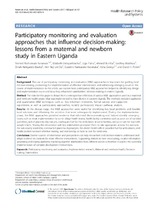| dc.contributor.author | Kananura, Rornald Muhumuza | |
| dc.contributor.author | Ekirapa-Kiracho, Elizabeth | |
| dc.contributor.author | Paina, Ligia | |
| dc.contributor.author | Bumba, Ahmed | |
| dc.contributor.author | Mulekwa, Godfrey | |
| dc.contributor.author | Nakiganda-Busiku, Dinah | |
| dc.contributor.author | Oo, Htet Nay Lin | |
| dc.contributor.author | Kiwanuka, Suzanne Namusoke | |
| dc.contributor.author | George, Asha S. | |
| dc.contributor.author | Peters, David H. | |
| dc.date.accessioned | 2018-01-03T09:54:16Z | |
| dc.date.available | 2018-01-03T09:54:16Z | |
| dc.date.issued | 2017 | |
| dc.identifier.citation | Kananura, R.M. et al. (2017). Participatory monitoring and evaluation approaches that influence decision-making: lessons from a maternal and newborn study in Eastern Uganda. Health Research Policy and Systems, 15(2): 107 | en_US |
| dc.identifier.issn | 1478-4505 | |
| dc.identifier.uri | http://dx.doi.org/10.1186/s12961-017-0274-9 | |
| dc.identifier.uri | http://hdl.handle.net/10566/3334 | |
| dc.description.abstract | BACKGROUND: The use of participatory monitoring and evaluation (M&E) approaches is important for guiding local
decision-making, promoting the implementation of effective interventions and addressing emerging issues in the
course of implementation. In this article, we explore how participatory M&E approaches helped to identify key design
and implementation issues and how they influenced stakeholders’ decision-making in eastern Uganda.
METHOD: The data for this paper is drawn from a retrospective reflection of various M&E approaches used in a maternal
and newborn health project that was implemented in three districts in eastern Uganda. The methods included qualitative
and quantitative M&E techniques such as key informant interviews, formal surveys and supportive
supervision, as well as participatory approaches, notably participatory impact pathway analysis.
RESULTS: At the design stage, the M&E approaches were useful for identifying key local problems and feasible
local solutions and informing the activities that were subsequently implemented. During the implementation
phase, the M&E approaches provided evidence that informed decision-making and helped identify emerging
issues, such as weak implementation by some village health teams, health facility constraints such as poor use of standard
guidelines, lack of placenta disposal pits, inadequate fuel for the ambulance at some facilities, and poor care for low birth
weight infants. Sharing this information with key stakeholders prompted them to take appropriate actions. For example,
the sub-county leadership constructed placenta disposal pits, the district health officer provided fuel for ambulances, and
health workers received refresher training and mentorship on how to care for newborns.
CONCLUSION: Diverse sources of information and perspectives can help researchers and decision-makers understand and
adapt evidence to contexts for more effective interventions. Supporting districts to have crosscutting, routine information
generating and sharing platforms that bring together stakeholders from different sectors is therefore crucial for the successful
implementation of complex development interventions. | en_US |
| dc.language.iso | en | en_US |
| dc.publisher | World Health Organization | en_US |
| dc.rights | © The Author(s). 2017 Open Access This article is distributed under the terms of the Creative Commons Attribution 4.0
International License (http://creativecommons.org/licenses/by/4.0/), which permits unrestricted use, distribution, and
reproduction in any medium, provided you give appropriate credit to the original author(s) and the source, provide a link to
the Creative Commons license, and indicate if changes were made. The Creative Commons Public Domain Dedication waiver
(http://creativecommons.org/publicdomain/zero/1.0/) applies to the data made available in this article, unless otherwise stated. | |
| dc.subject | Participatory monitoring and evaluation | en_US |
| dc.subject | Implementation research | en_US |
| dc.subject | Maternal and newborn health | en_US |
| dc.subject | Decisionmaking | en_US |
| dc.subject | Stakeholders | en_US |
| dc.title | Participatory monitoring and evaluation approaches that influence decision-making: lessons from a maternal and newborn study in Eastern Uganda | en_US |
| dc.type | Article | en_US |
| dc.privacy.showsubmitter | FALSE | |
| dc.status.ispeerreviewed | TRUE | |

